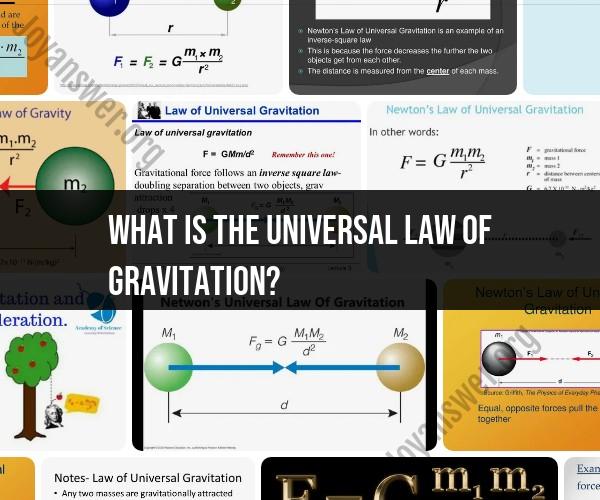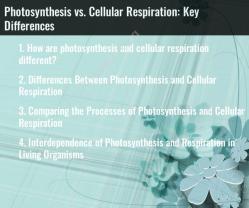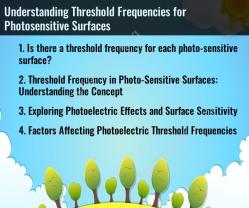What is the universal law of gravitation?
The Universal Law of Gravitation, formulated by Sir Isaac Newton in 1687, is a fundamental principle in physics that describes the force of gravity between two objects. It explains how objects are attracted to each other due to their masses. Here's an explanation of the Universal Law of Gravitation:
The Law:
The Universal Law of Gravitation states that every point mass attracts every other point mass by a force acting along the line intersecting both points. This force is directly proportional to the product of the masses of the objects and inversely proportional to the square of the distance between them.
The Formula:
The mathematical representation of this law is as follows:
Where:
- represents the gravitational force between the two objects.
- is the gravitational constant, which is a universal constant that has the same value throughout the universe.
- and are the masses of the two objects.
- is the distance between the centers of the two objects.
Key Points:
Inverse Square Law: The law shows that the force of gravity decreases as the square of the distance between two objects increases. In other words, if you double the distance between two objects, the gravitational force becomes one-fourth of what it was at the original distance.
Proportional to Mass: The force of gravity is directly proportional to the product of the masses of the two objects. This means that if you increase the mass of one or both objects, the gravitational force between them also increases.
Gravitational Constant: The constant is a fundamental constant of nature. It's a very small number, and its value was determined through experiments. It ensures that the units used in the formula are consistent and that the law applies universally.
Applicability: The Universal Law of Gravitation applies not only to objects on or near Earth but to all objects with mass in the universe. It's what keeps planets in orbit around the Sun, the Moon orbiting Earth, and satellites in orbit around Earth.
Weight: On Earth, the weight of an object is the result of the gravitational force acting on it due to the Earth's mass. Weight is equal to the mass of an object multiplied by the acceleration due to gravity (approximately 9.8 m/s² on Earth).
Action and Reaction: According to Newton's third law of motion, the force of gravity is mutual. If object A exerts a gravitational force on object B, object B simultaneously exerts an equal and opposite gravitational force on object A.
The Universal Law of Gravitation is a foundational principle of classical physics and has played a crucial role in our understanding of the universe. It explains why celestial bodies are attracted to each other and why objects fall to the ground when dropped. Additionally, this law forms the basis for understanding orbits, the motion of planets, and the behavior of objects in space.
The Universal Law of Gravitation, formulated by Sir Isaac Newton in 1687, is a fundamental principle in physics that describes the force of gravity between two objects. It explains how objects are attracted to each other due to their masses. Here's an explanation of the Universal Law of Gravitation:
The Law:
The Universal Law of Gravitation states that every point mass attracts every other point mass by a force acting along the line intersecting both points. This force is directly proportional to the product of the masses of the objects and inversely proportional to the square of the distance between them.
The Formula:
The mathematical representation of this law is as follows:
Where:
- represents the gravitational force between the two objects.
- is the gravitational constant, which is a universal constant that has the same value throughout the universe.
- and are the masses of the two objects.
- is the distance between the centers of the two objects.
Key Points:
Inverse Square Law: The law shows that the force of gravity decreases as the square of the distance between two objects increases. In other words, if you double the distance between two objects, the gravitational force becomes one-fourth of what it was at the original distance.
Proportional to Mass: The force of gravity is directly proportional to the product of the masses of the two objects. This means that if you increase the mass of one or both objects, the gravitational force between them also increases.
Gravitational Constant: The constant is a fundamental constant of nature. It's a very small number, and its value was determined through experiments. It ensures that the units used in the formula are consistent and that the law applies universally.
Applicability: The Universal Law of Gravitation applies not only to objects on or near Earth but to all objects with mass in the universe. It's what keeps planets in orbit around the Sun, the Moon orbiting Earth, and satellites in orbit around Earth.
Weight: On Earth, the weight of an object is the result of the gravitational force acting on it due to the Earth's mass. Weight is equal to the mass of an object multiplied by the acceleration due to gravity (approximately 9.8 m/s² on Earth).
Action and Reaction: According to Newton's third law of motion, the force of gravity is mutual. If object A exerts a gravitational force on object B, object B simultaneously exerts an equal and opposite gravitational force on object A.
The Universal Law of Gravitation is a foundational principle of classical physics and has played a crucial role in our understanding of the universe. It explains why celestial bodies are attracted to each other and why objects fall to the ground when dropped. Additionally, this law forms the basis for understanding orbits, the motion of planets, and the behavior of objects in space.












